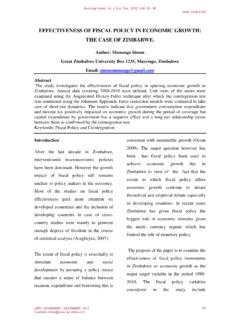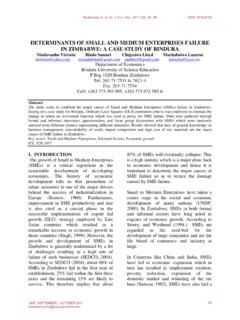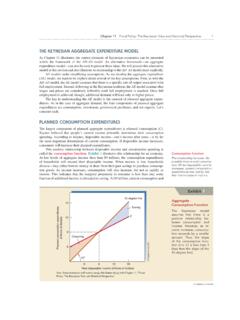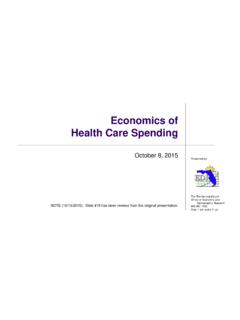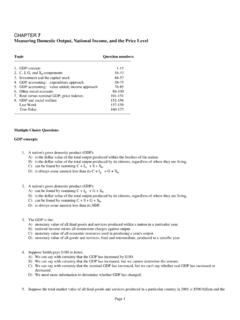Transcription of An Empirical Analysis of Aggregate Import Demand and ...
1 An Empirical Analysis of Aggregate Import Demand and expenditure Components in Namibia Emmanuel Ziramba1 and Mooya Bbuku2 Abstract This paper examines the long run and short run relationships between Namibian Aggregate imports and expenditure components using time series data for the period 1980-2009. An autoregressive distributed lag modeling process is used to capture the effects of final consumption expenditure (FCE), investment expenditure (INV), export expenditure (X) and relative prices (RP) on imports. The major findings were as follows. Firstly, Aggregate Import Demand is co-integrated with its determinants. Secondly, different expenditure components have different Import contents both in the long and short run periods. In the long run, investment expenditure , final consumption expenditure and relative prices are the major determinants of Aggregate Import Demand in Namibia.
2 Keywords: bounds test approach, cointegration, expenditure components, Import Demand JEL Classifications: C22, C51, F10, F14 I. INTRODUCTION Namibia is an upper middle income country with a GDP per capita of N$35,459 (Central Bureau of Statistics, 2009). Imports play an important role in the development of the Namibian economy. Namibia imports mainly from South Africa. According to the National Accounts published by the Central Bureau of Statistics (2009) the major products that contributed to the total imports of goods over the years have been among other things transport equipment and petroleum products. This study is justified by the following considerations. First, to the best of our knowledge there has not been any study that has estimated the Aggregate Import Demand function for Namibia.
3 Secondly, a number of Empirical studies in other countries have confirmed that different components of final Demand expenditure have different Import contents (Giovannetti, 1986; Thirlwall and Gibson, 1992; Abbott and Seddighi, 1996; Mohamed and Tang, 2000; Tang, 2002; Ziramba, 2012). Mohamed and Tang (2000) have argued that exports are known to have high Import content. By disaggregating the Demand variable we are able to isolate the effects of the various Demand components on Aggregate imports and avoid the possibility of a specification error. Secondly, by drawing upon some latest advances in econometric time series modelling we can handle the problems that arise as a result of the presence of non-stationary data.
4 To the best knowledge of the authors the present study is the first to examine the Aggregate Import Demand function for Namibia. Following studies by Tang (2002), Ho (2004), Mohamed and Tang, (2000) and Ziramba (2012), we use the disaggregated components of Aggregate final expenditure together with the standard relative price variable to specify the Aggregate Import Demand model for Namibia. Our specific objectives are to examine the long 1 Corresponding author and Professor of Economics, Department of Economics, University of Namibia, Private Bag 13302 Pioneerspark, Windhoek, Namibia, Email: 2 Was an Honours student in the Department of Economics, University of Namibia, when the paper was written.
5 Email: Emmanuel Ziramba and Mooya Bbuku., Int. J. Eco. Res., 2013, v4i4, 39 - 50 ISSN: 2229-6158 IJER | JULY - AUGUST 2013 Available run and short run relationships between Aggregate imports and the individual components of expenditure in Namibia over the period 1980 to 2009; and to estimate the Import elasticities with respect to the expenditure components. The structure of the paper is as follows. Section 2 gives a theoretical background. Section 3 provides a discussion of Empirical studies on the subject focusing studies that used that disaggregated the income ( Demand ) variable. The model, data and methods are presented in section 4. Estimation results are presented in section 5. Conclusion and policy implications are presented in section 6.
6 II. THEORETICAL OVERVIEW The traditional approaches to estimating the Import Demand function relates quantity of imports to the relative price of imports. Theory further suggests that there is a negative relationship between imports and the relative price level that means an increase in relative price level reduces the level of imports. The positive relationship between the level of income and imports implies that an increase in the level of income will lead to an increase in the amount of imports which can be attributed to an increase in consumption expenditure , investment spending or an increase in government expenditure . This is illustrated below: ),(tttRPYfM (1) Where tM represents the quantity of imports in period t, tRP is the relative price of imports, defined as the ratio of Import price, PM to domestic price, PD and ty the level of income level in period t.
7 Another approach of estimating the Import Demand functions as stated by Abbott and Seddighi (1996) identifies three major factors in determining a country s Demand for competitive imports. Firstly, the level of final expenditure that is consumption expenditure by the private and public sectors, investment expenditure and expenditure on exports. The composition of expenditure is vital to the extent that the Import content of the different components of expenditure differs. Secondly, the price of imports relative to the price of domestic substitutes as a major determinant of Demand for imports. This entails that an increase in the relative price level will lead to a fall in the Demand for imports assuming that domestic prices are flexible and would change to eliminate excess Demand in the domestic economy.
8 Finally, the capacity of the country to produce and supply the goods The Import function is therefore specified as below: M = f (FCE, INV, X, RP) (2) Where: M and RP are as defined above, FCE is final consumption expenditure which is the sum of private and public consumption, INV is expenditure on investment goods which is a proxy for gross domestic fixed capital formation and stock building and X is expenditure on exports. 3 The capacity factor is essentially a short term phenomenon and is only relevant if the excess Demand at home cannot be eliminated by a change in the domestic price level. (Abbott and Seddighi, 1996) Emmanuel Ziramba and Mooya Bbuku., Int. J. Eco. Res., 2013, v4i4, 39 - 50 ISSN: 2229-6158 IJER | JULY - AUGUST 2013 Available III.
9 REVIEW OF RELEVANT Empirical LITERATURE There have been numerous Empirical studies on both developed and developing countries on the traditional approach to estimating Import Demand functions as illustrated by equation (1). Some of these studies are reviewed below. Abbott and Seddighi (1996) estimated the Import Demand function using the Johansen multivariate co-integration Analysis for the long run and the Engle-Granger representation theorem in order to examine the short run behaviour of imports. Their results revealed that the major determinant of the UK Aggregate Import in the long run is consumption expenditure . Furthermore there was a significant difference in the partial elasticities of Demand of imports with respect to consumption expenditure , investment expenditure and expenditure on exports with the estimated elasticities of , and respectively.
10 A study by Dash (2005) on the Aggregate Import Demand function for India used yearly time series data and applied the Johansen Juselius multivariate co-integration technique during 1975 to 2003. The study used co-integration and error correction model (ECM) to integrate the dynamics of the short run (changes) with long run (levels) adjustment process. The variables used were gross domestic product, unit value of Import prices, prices of domestically produced goods and foreign exchange reserves. Their study suggested that Import Demand in India is largely explained by price of domestically produced goods, GDP, lag of Import and foreign exchange reserves. Tang (2002) investigates the Malaysian Import Demand function on consumption, investment, exports and relative price for the period 1968 to 1998.
